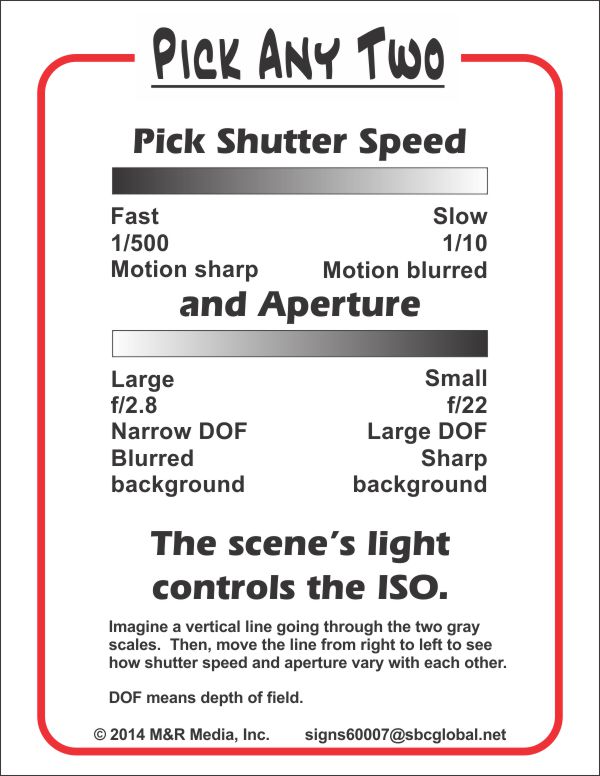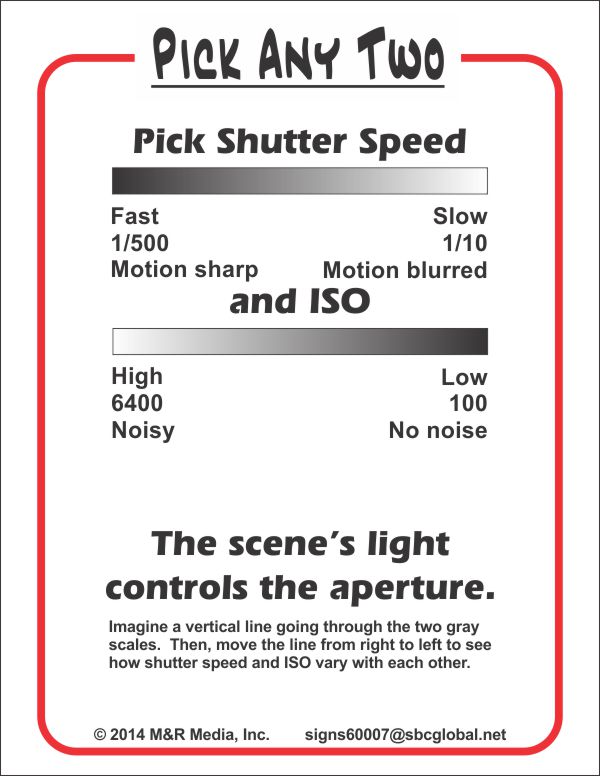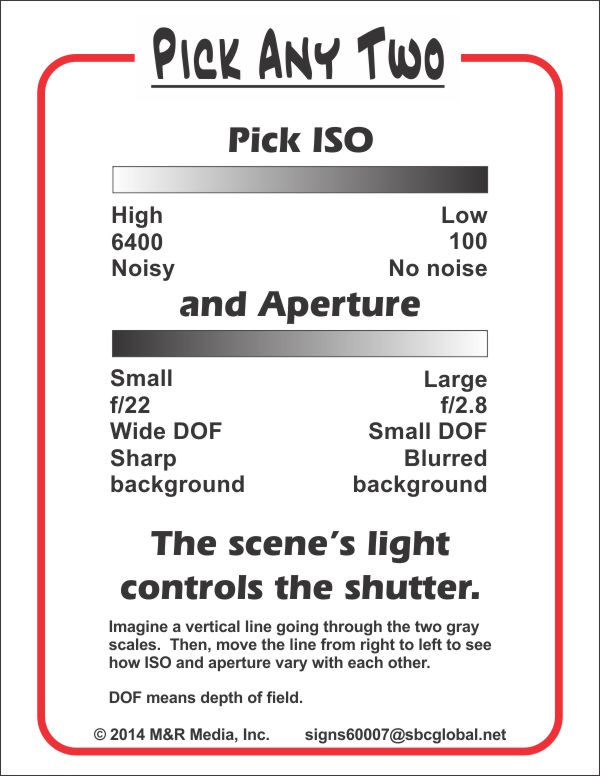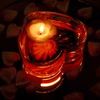The dilemma of the exposure triangle
Dec 8, 2014 10:13:03 #
The exposure triangle is a familiar concept and presents the three key variables for exposure: shutter speed, aperture and ISO. You need all three to make a picture. However, most discussions either ignore or gloss over the fact that the photographer can pick only two of the three variables at a time. Once he or she does, then the amount of light present determines the third. This is the technical reality and artistic considerations may override it.
Another problem with the exposure triangle is that it does not clearly show how one variable affects another. For example, how does changing the shutter speed affect the aperture or ISO and what do you gain or not gain for it. For experienced photographers, this is trivial. However, for beginners, this can be baffling.
Therefore, to help beginners, I transformed the exposure triangle into a scheme called "Pick Any Two". Any two of the three exposure variables gives three combinations of shutter speed, aperture and ISO. The pictures below show each combination, how the two independent variables affect each other, and the various trade-offs. The values shown are only examples and should not be taken literally.
I look forward to comments on how to improve this. If you would like a PDF, please send me a private message.
Another problem with the exposure triangle is that it does not clearly show how one variable affects another. For example, how does changing the shutter speed affect the aperture or ISO and what do you gain or not gain for it. For experienced photographers, this is trivial. However, for beginners, this can be baffling.
Therefore, to help beginners, I transformed the exposure triangle into a scheme called "Pick Any Two". Any two of the three exposure variables gives three combinations of shutter speed, aperture and ISO. The pictures below show each combination, how the two independent variables affect each other, and the various trade-offs. The values shown are only examples and should not be taken literally.
I look forward to comments on how to improve this. If you would like a PDF, please send me a private message.
Pick Any Two, page 1

Pick Any Two, page 2

Pick Any Two, page 3

Dec 8, 2014 10:29:00 #
It's definitely a good start. It took me reading lots of books, articles, youtube videos and practice, practice, practice to make this second nature. You've boiled it down well.
Dec 8, 2014 10:41:52 #
Very nicely done. Very handy quick references. Thanks for sharing. Have a GREAT DAY!
Dec 8, 2014 10:48:54 #
abc1234 wrote:
The exposure triangle is a familiar concept and pr... (show quote)
I always thought the exposure "Pie" was a better term than triangle.
Dec 8, 2014 11:01:17 #
U
The thing that is still missing is the ratio that if you increase the speed by a stop you loose half of the light and need to double the aperture or ISO. Gradient values added the the bars might help show this ratio.
abc1234 wrote:
The exposure triangle is a familiar concept and pr... (show quote)
The thing that is still missing is the ratio that if you increase the speed by a stop you loose half of the light and need to double the aperture or ISO. Gradient values added the the bars might help show this ratio.
Dec 8, 2014 11:02:22 #
Thank you Mr Pc and pixbyjnjphotos. Wyoming, I am not familiar with the pie so I cannot comment on it. Post it if you wish.
Dec 8, 2014 11:23:43 #
skiman wrote:
U
The thing that is still missing is the ratio that if you increase the speed by a stop you loose half of the light and need to double the aperture or ISO. Gradient values added the the bars might help show this ratio.
The thing that is still missing is the ratio that if you increase the speed by a stop you loose half of the light and need to double the aperture or ISO. Gradient values added the the bars might help show this ratio.
You are entirely correct. I did not want to quantitate all this because my goal is for beginners to understand the concepts first. They have to grasp the concepts before dealing with numbers.
Photographic nomenclature is a mess. If you double the shutter speed, you do indeed get half the light. If you double the ISO, you need only half the light. If you double the f/stop, then you get one fourth the light. What! Take f/4 and double it. You get f/8. Right? If you stop down, then why do the numbers go up? That is why I say photographic nomenclature is a mess. And that is one reason why I did not include more numbers in Pick Any One. KISS
Dec 8, 2014 12:03:44 #
johnmowry
Loc: Northern Indiana, USA
If you want to really confuse the beginners, you could make it a quadrangle, with the fourth factor being the amount of light. Picking the other three determines how much light is needed. If there's not enough existing light, you need to supplement it. Best to leave that for later, after they understand the triangle!
John
John
Dec 8, 2014 12:22:42 #
Dec 8, 2014 13:17:16 #
johnmowry wrote:
If you want to really confuse the beginners, you could make it a quadrangle, with the fourth factor being the amount of light. Picking the other three determines how much light is needed. If there's not enough existing light, you need to supplement it. Best to leave that for later, after they understand the triangle!
John
John
John, you are right and wrong. You are certainly right in saying that we are really working in four dimensions. However, as a teaching tool, how about keeping things simple?
Dec 8, 2014 13:17:55 #
rpavich wrote:
I think you did a good job...it's a good visual reference point.
Thank you and that is all is wished to accomplish.
Dec 8, 2014 13:30:42 #
If a situation is exaggerated it is often easier to visualise, which is exactly what your cards are doing. Going from very fast to very slow, from wide open to tight shut.
The concept is then simple, add too many details and complexities, instead of learning the concept, the student may be bogged down with side issues.
Great teaching aids
The concept is then simple, add too many details and complexities, instead of learning the concept, the student may be bogged down with side issues.
Great teaching aids
Dec 8, 2014 13:34:08 #
abc1234 wrote:
Photographic nomenclature is a mess. ...... If you double the f/stop, then you get one fourth the light. What! Take f/4 and double it. You get f/8. Right? If you stop down, then why do the numbers go up? KISS
Photographic nomenclature is a mess. ...... If you double the f/stop, then you get one fourth the light. What! Take f/4 and double it. You get f/8. Right? If you stop down, then why do the numbers go up? KISS
It is a mess. But it's the only way it could be. The clumsy system is the only way to maintain consistency between lenses and film/sensor formats.
Dec 8, 2014 13:36:10 #
Searcher wrote:
If a situation is exaggerated it is often easier to visualise, which is exactly what your cards are doing. Going from very fast to very slow, from wide open to tight shut.
The concept is then simple, add too many details and complexities, instead of learning the concept, the student may be bogged down with side issues.
Great teaching aids
The concept is then simple, add too many details and complexities, instead of learning the concept, the student may be bogged down with side issues.
Great teaching aids
Thank you Searcher. Coming from you is a real complement.
Dec 8, 2014 13:38:17 #
mcveed wrote:
It is a mess. But it's the only way it could be. The clumsy system is the only way to maintain consistency between lenses and film/sensor formats.
At least the aperture is a dimensionless number. Imagine teaching someone about lens diameters and focal lengths in order to understand how much light is entering the lens!
If you want to reply, then register here. Registration is free and your account is created instantly, so you can post right away.







